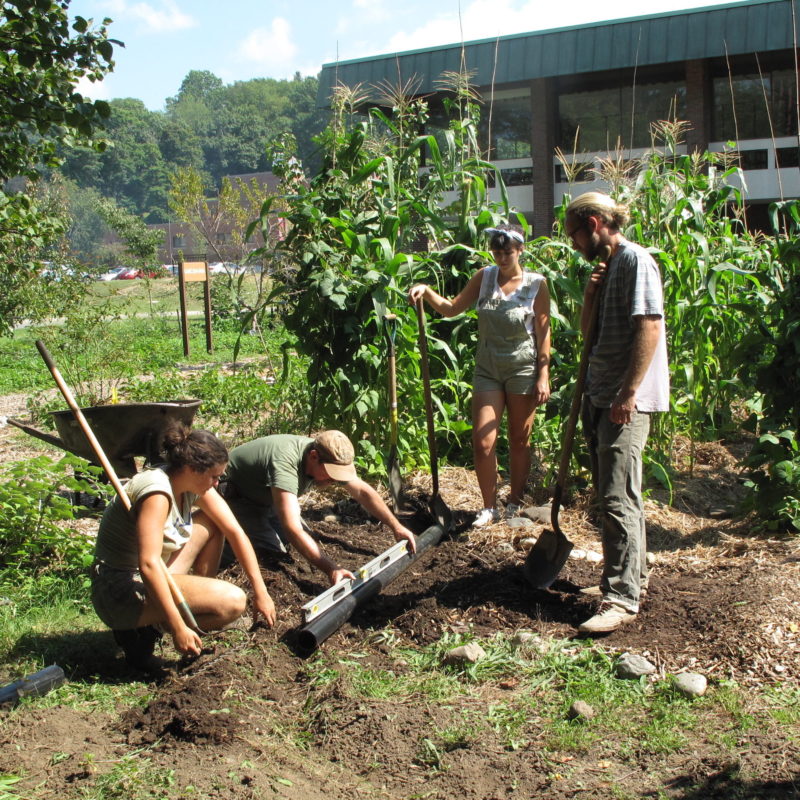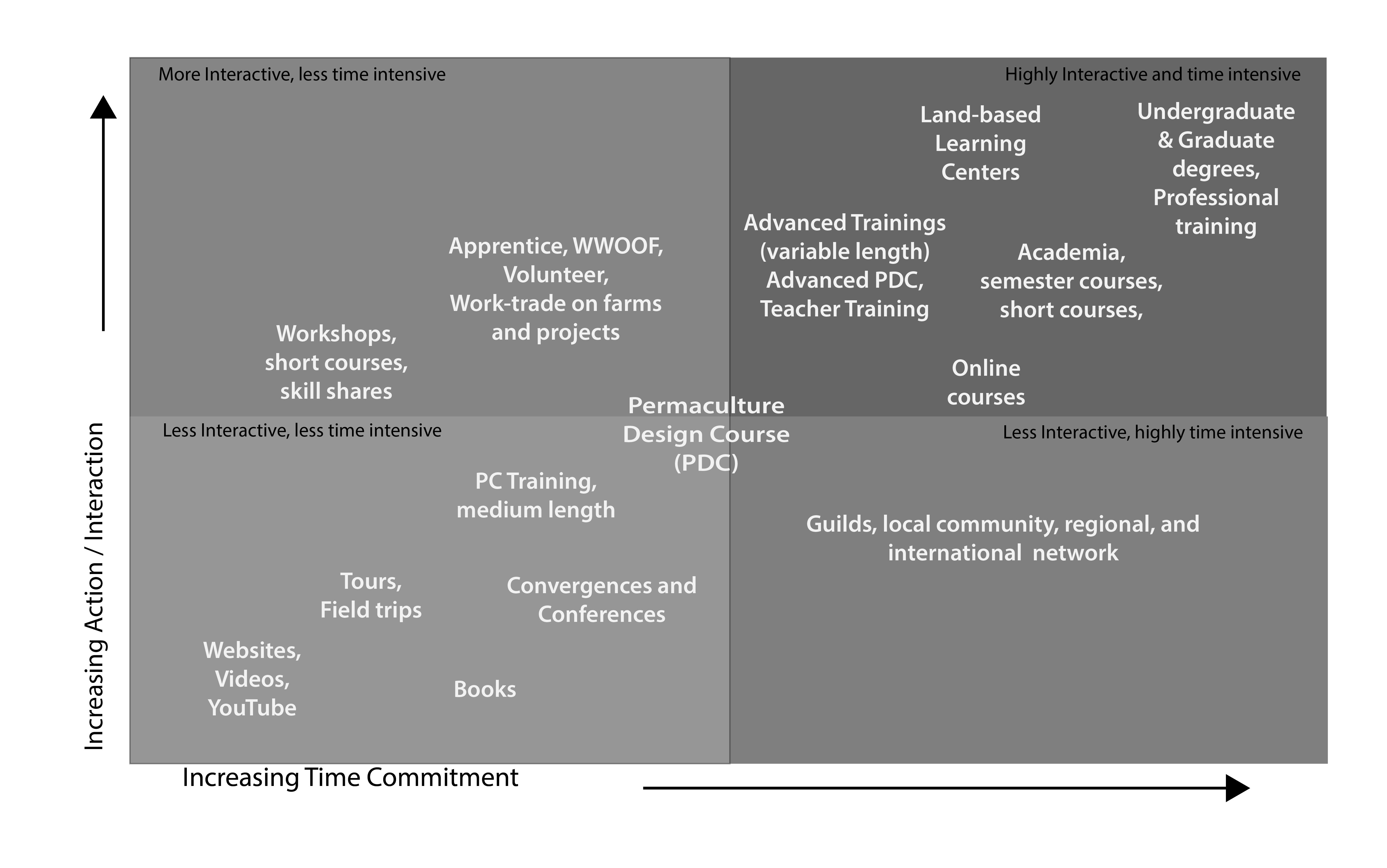
Mapping the Permaculture Education Ecosystem
There is a wide spectrum of permaculture education formats in practice today. The diversity of approaches reflects a growing interest in permaculture throughout many sectors, well beyond the homestead. In October 2014, a consortium of permaculture teachers, designers and organizers met at the Omega Institute in Rhinebeck, NY to map the world of permaculture education. Participants brainstormed the ecosystem elements and noted questions, opportunities, concerns, and patterns. There have been many of these conversations over the years with the goal of better understanding what courses are offered and how to better serve a wider audience. The permaculture network is very dispersed and dynamic. It is not something to be controlled, but rather worked with. As we identify opportunities to build a stronger education system and fill missing niches, we can ensure quality and vibrancy in permaculture education.

The group recognized a critical aspect of permaculture education began with inspiration. Empowerment (the preparedness and readiness to affect change in their own lives and communities) comes next, and then finally proficiency (skills and abilities to do the work in the world they are inspired to).
The popularity of the 14-day, 72-hour Permaculture Design Course (PDC) has led to a belief that this is the main pathway for learning. The residential PDC was for some time the primary format for permaculture education. But, as many people have noted, an expensive, residential program is simply not available to most people. As outlined below, there are many elements of the permaculture education ecosystem that are available outside of the structure of the PDC.

One design approach to regulating the PDC certificate would be a diploma system and an organization that certifies the teachers and designers (e.g. Permaculture Institute of North America). At the Omega retreat, we discussed a more “crowd-sourced” approach, where a database could offer prospective students information about courses, teachers and student feedback. Teachers could take a voluntary “pledge” to cover some core curriculum and core competencies agreed upon through an open process within the permaculture education community.
Elements of the Permaculture Education Ecosystem:
- Internet, websites and videos (e.g. YouTube)
- Books and magazines
- Tours and field trips
- Convergences and conferences
- Short workshops (1 hour to 2-3 days)
- Medium-length trainings (e.g. UPAT-NYC, 3-8 days)
- PDC in various formats – weekends, modular, online-distance (10-30 days)
- Online courses
- Advanced Trainings – Advanced PDC, Teacher Training (5-10 days, variable length)
- Apprentice, WWOOFing, volunteer, work-trade
- Land-based learning centers (e.g. Kinstone)
- Diploma Programs (1 to 3 years)
- Academia – short courses, semester courses, symposia
- Undergraduate degree, advanced degree, professional training (e.g. Conway School of Landscape Planning and Design)
- Guilds, local, regional and international network (e.g. Permaculture Institute of the Northeast, European Permaculture Teachers Partnership), network learning
As permaculture designers, we have an understanding of the resilience of diverse and interconnected ecosystems. Mapping the permaculture education ecosystem illuminates numerous observations and opportunities:
- The diversity of learning formats and approaches IS a dynamic, evolving ecosystem. There are gaps and overlaps, which may be seen as problems, but which also offer opportunities and unexplored niches.
- Overlap and redundancies in offerings can push towards getting out to wider audiences and create innovation leading to diversifying and creativity.
- Various “pathways” can be used by learners to reach diverse education goals.
- Sometimes learners have clear goals and sometimes they don’t.
- It is not necessary to become a certified permaculture designer to bring permaculture into whatever life path one chooses.
- There is an increasing number of opportunities for advanced training, and yet in some places, opportunities for introductory permaculture learning may be limited.
- Defining core competencies may help to identify basic skills that the permaculture community deems essential in practicing permaculture. (Competencies are knowledge and skills to be gained, and should be distinguished from curricula.)
- Many educators agree that there needs to be a revision and rethinking of the “core curriculum” to adapt to changing conditions and to balance the delivery of core content through lecture and presentations with skill-building and hands-on activities that cater to different learning styles.
- Contact hours versus course length: PDC course lengths vary widely and so the actual “contact hours,” the time students are in contact with the lead instructor, varies widely. Originally, contact hours were meant to be 72 hours excluding design time, videos, and evening activities. At this point, educators marketing courses may be counting course hours very differently.
- With so many educational opportunities and different learning formats, the “PDC” is only one of many potential learning opportunities. The idea that the PDC is necessary and the only pathway to permaculture education is erroneous.
Concluding Thoughts
The time is right to revise the concept of permaculture education and to acknowledge new forms beyond just the PDC. As guides and mentors, we might begin by helping students define their learning goals. As educators, we might begin by defining our goals within a certain educational experience. As a network, at this point in our development, it would behoove us to articulate what content is essential to the core of a basic permaculture certificate. Once some kind of core content and curriculum is established, then other more advanced or applied modules can be put in place. An effort is underway, within our region, to define core competencies or skills that students may expect from a basic certificate course.
Permaculture education has naturally evolved beyond the PDC into more of an “educational ecosystem,” in which new elements and new pathways have emerged. “Educator guilds” may form to share curricula and establish basic educational guidelines. Rather than an external body regulating permaculture education and certification, we may choose an open and transparent “pledge” that articulates core content, core competencies, cultural values (like humility, inclusiveness and being of service) and pedagogical methods (like action learning, hands-on skill-building and participatory components). This will allow students to know what is being taught, so they can make their own informed choices. Self-organizing educator guilds may provide opportunities for peer-review, professional development and the sharing of best practices on how to teach content and skills in dynamic ways. Our hope is to lift all boats, thus resulting in virtuous cycles of ever-improving permaculture education for all participants in a collegial and collaborative rather than a competitive fashion.
Writers: Jono Neiger (western Massachusetts) with assistance from Jesse Watson (Rockland, Maine), Bonita Ford (Perth, Ontario) and Steve Gabriel (Ithaca, NY). With graphic assistance from Helena Farrell (Western Massachusetts)



Excellent article, and very timely seeing the biannual NAPC is only a few days away! I love the permaculture-approach to permaculture education, using “educator guilds” in the “educational ecosystem”. This is the kind of thinking that we need to build upon. I will definitely be referring back to this post while at NAPC and in contemplating the future of PC education in North America.
Could we please stop using the word ‘ecosystem’ to depict a system consisting of only one species – humans?
Hey Will, i think you’ll find that the term ‘ecosytem’ is being used metaphorically in this context and not literally, as in, there are lots of species of permaculture courses to be experienced. The 72 hour PDC sits at the top of the food chain or more accurately, is the most dominant course around but there are many other ‘species’, such as the one day workshop, the humble book or even the less common but quite intimidating Diploma course.